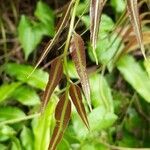Scrambling, long creeping fern, or high climbing epiphyte with base rooted to the ground, fronds widely spaced, horizontal to pendulous with drooping pinnae. Rhizome 4-7 mm diam., pale green, sometimes slightly glaucous, smooth, with scattered, dark, small, orbicular scales, especially towards the apex, the growing tip completely covered. Fronds 30-80 cm long, including a stipe of 5-20 cm long, sterile pinnae for the most part articulate to the rhachis, lanceolate to oblong-lanceolate, 7-20 by 1.5-5.5 cm, tip acute, slightly attenuate, base often asymmetric, mostly cuneate, with a small dark gland on the apical side, margin almost entire to serrulate, especially at the apex; fertile pinnae linear, 15-25 cm by 2-3 mm. Spores evenly tuberculate.
Rhizome climbing or scrambling. Fronds dimorphic, 24–70 (–165) cm long, 9–30 cm wide. Stipe 8–30 (–82) cm long, stramineous to brown, glabrous or with peltate ± entire reddish brown scales. Lamina ovate, pinnate, with 4–14 pairs of pinnae. Rachis and costae stramineous to brown, glabrous. Sterile pinnae narrowly ovate, long-acuminate, 5–20 cm long, 1–5 cm wide, shortly stalked, sharply serrate; basal pinnae not reduced. Fertile pinnae 2–3 mm wide. Spores 41 × 27 µm, verrucose and minutely vermiculate to scaberulous.
A climbing or scrambling fern with a thin smooth rhizome which climbs up sago palms and tree trunks. It can be 20 m long. The stems are brown smooth and less than 1 cm across. They are only sparingly branched. The fronds are up to 80 cm long and have leaflets. The fronds droop. The fronds have several leaflets and are often red in colour when young. Fertile fronds when they occur, are at the top and are thin.


